Hokkaido Milk Bread
Super fluffy and soft, this Hokkaido milk bread uses a tangzhong method to create an extra fluffy bread. Hokkaido milk bread is also known as Japanese milk bread.
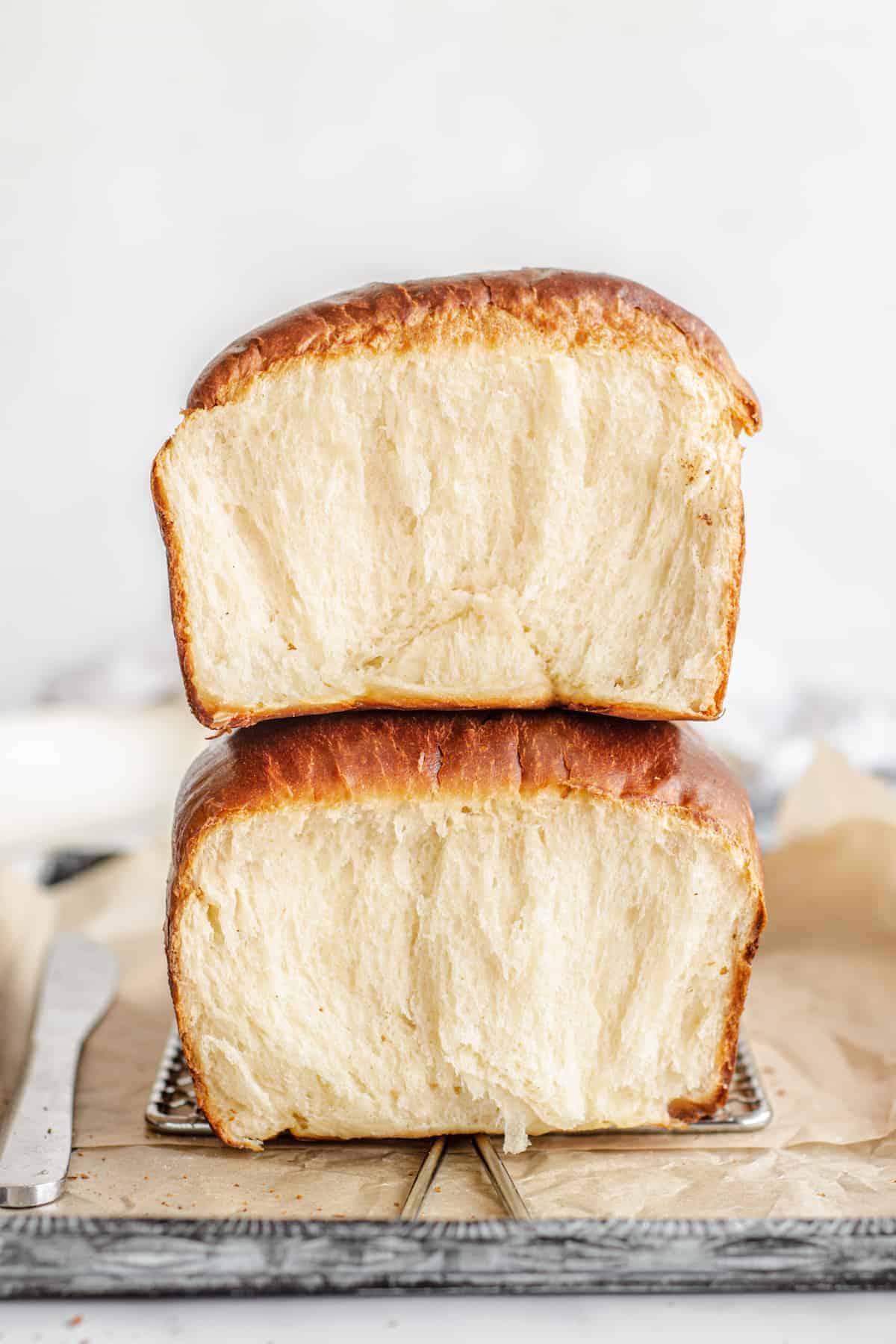
This Hokkaido milk bread recipe is a great recipe for sandwich bread. It also is great for french toast. It’s a slightly sweet bread with the best texture, reminiscent of brioche but not as rich and much more fluffy.
In a tangzhong method, a small amount of flour is cooked in milk or water into a thick paste. What this does is it pre-gelatinizes the starches in the flour so that they can absorb more water. Flour can absorb twice as much hot liquid as cold liquids. The texture of this thick paste will be gelatinous and thick, and it’s a great way to add extra moisture to a bread dough without losing structure.
The main difference in tangzhong milk bread, as opposed to regular bread, is the extra moisture. This creates a fluffy texture and gives the bread longer shelf life.
Ingredients
Find the full list of ingredient amounts in the printable recipe card at the bottom of this post. Here is a rundown of what you will need.
- Bread flour. You could also use a strong all-purpose with a protein level of at least 11%.
- Whole milk
- Egg – for the bread and the egg wash.
- Granulated sugar – gives the bread a slight sweetness.
- Salt
- Instant yeast or active dry yeast. The yeast used in this recipe can be instant yeast or active dried yeast. Instant yeast will rise faster than active dried yeast. Whichever one you use, it needs to be viable. Usually, the instant yeast sachets are pretty foolproof, but sometimes active dried yeast can lose viability.
- Unsalted butter, room temperature. You could use salted butter too, but you might want to decrease the added salt in the recipe.
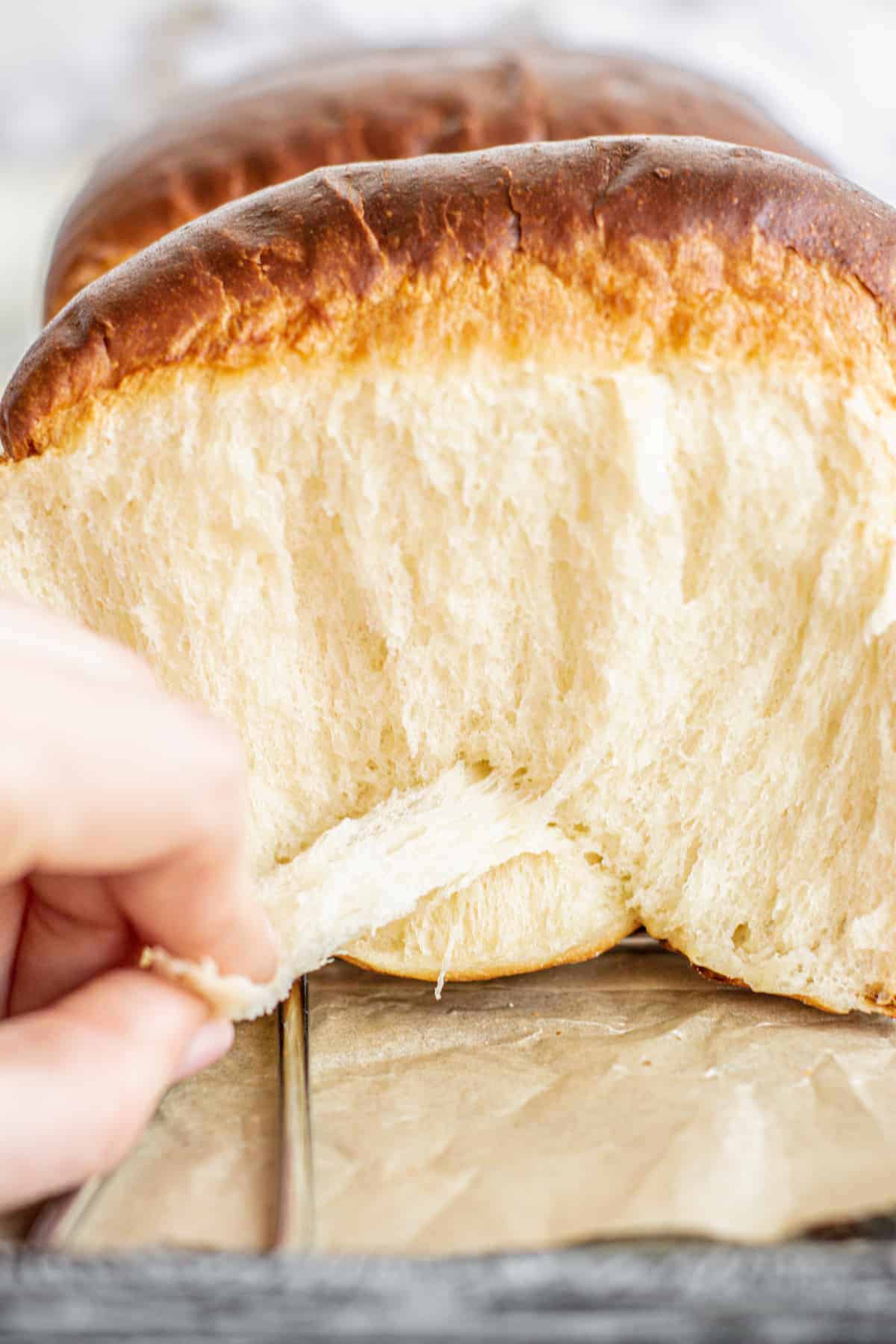
Equipment
The dough for this Japanese milk bread recipe is very sticky to work with. It’s best made in a stand mixer fitted with a dough hook attachment. You could also use a bread machine.
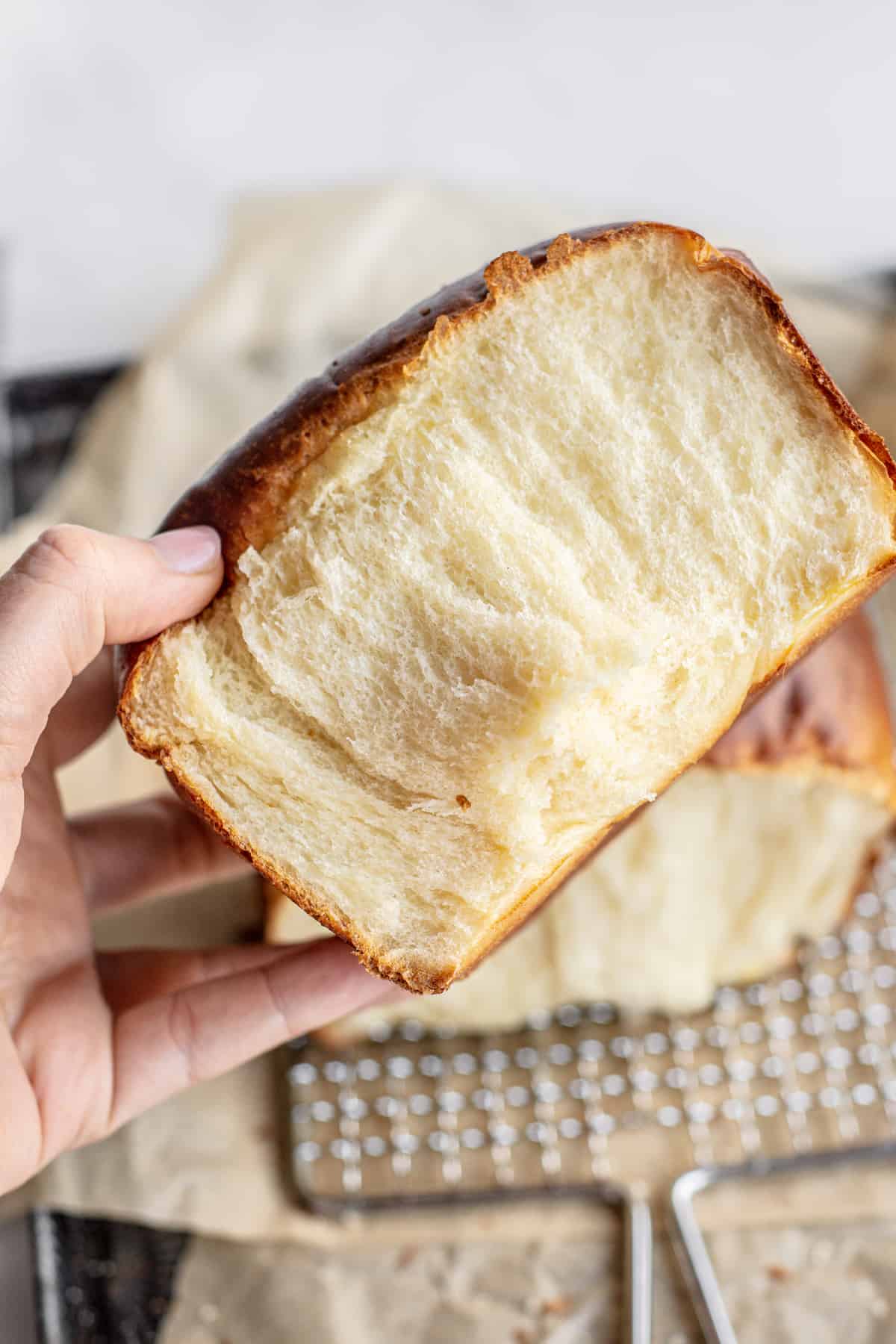
Hokkaido bread method
Combine the flour and the milk for the tangzhong in a small saucepan. Place this over medium heat and whisk until the mixture is cooked into a thick paste.
Remove it from the heat and scrape it into a small bowl. Let it cool down until just lukewarm to the touch.

While the tangzhong is cooling, combine the warm milk, sugar, and yeast in the bowl of a stand mixer.
If using active dry yeast, let this sit for around 5-10 minutes until it becomes foamy; if using instant yeast this step can be skipped.
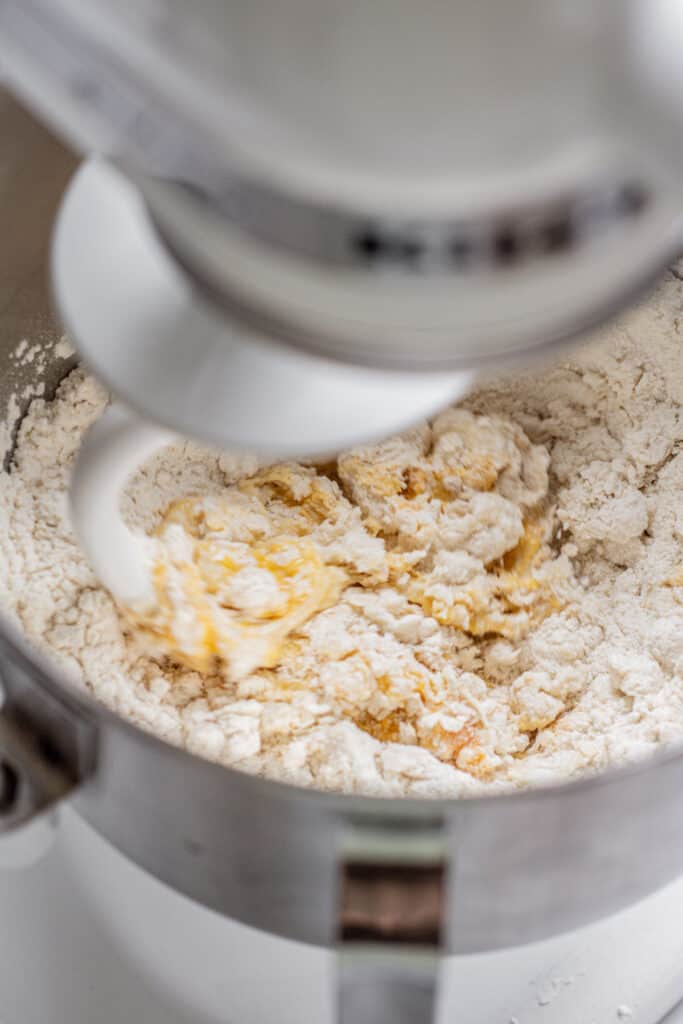
Add in the cooled tangzhong, the dough flour, egg and salt.Turn the mixture onto low speed and combine it into a shaggy dough.
Turn the mixer to medium speed and mix for 5 minutes until the dough strengthens.
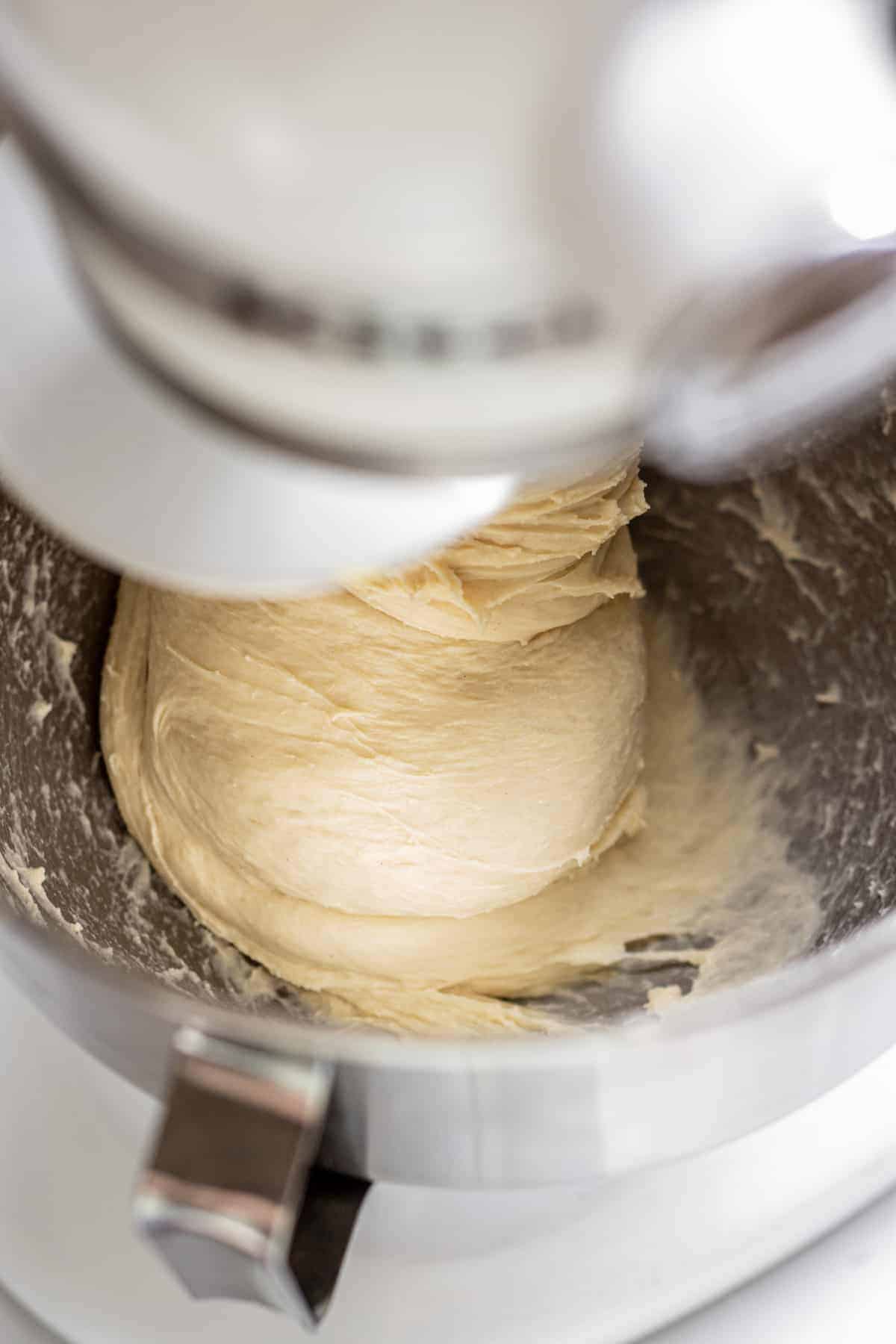
Add in the softened butter a few cubes at a time.
Continue kneading for a further 15 minutes until the sticky dough is strong and pulls away from the sides of the bowl.
Window pane test
Let the dough rest for 5 minutes, then break off a piece and see if it can stretch out really thin without tearing.
This is called the window pane test and is a good way to see that the gluten has developed enough.
First rise
Add the dough to a lightly oiled bowl and cover it with plastic wrap, a damp kitchen towel or a lid.
Let the dough rise in a warm place until doubled in size, around about 1 hour. The exact rise time will depend on your room temperature.
Shaping the final dough

Punch down the dough and pull it from the bowl onto a lightly floured surface.
Weight the dough, then cut it into 3 equal pieces. Use a scale to get really equal proportions. Shape each piece into a ball.
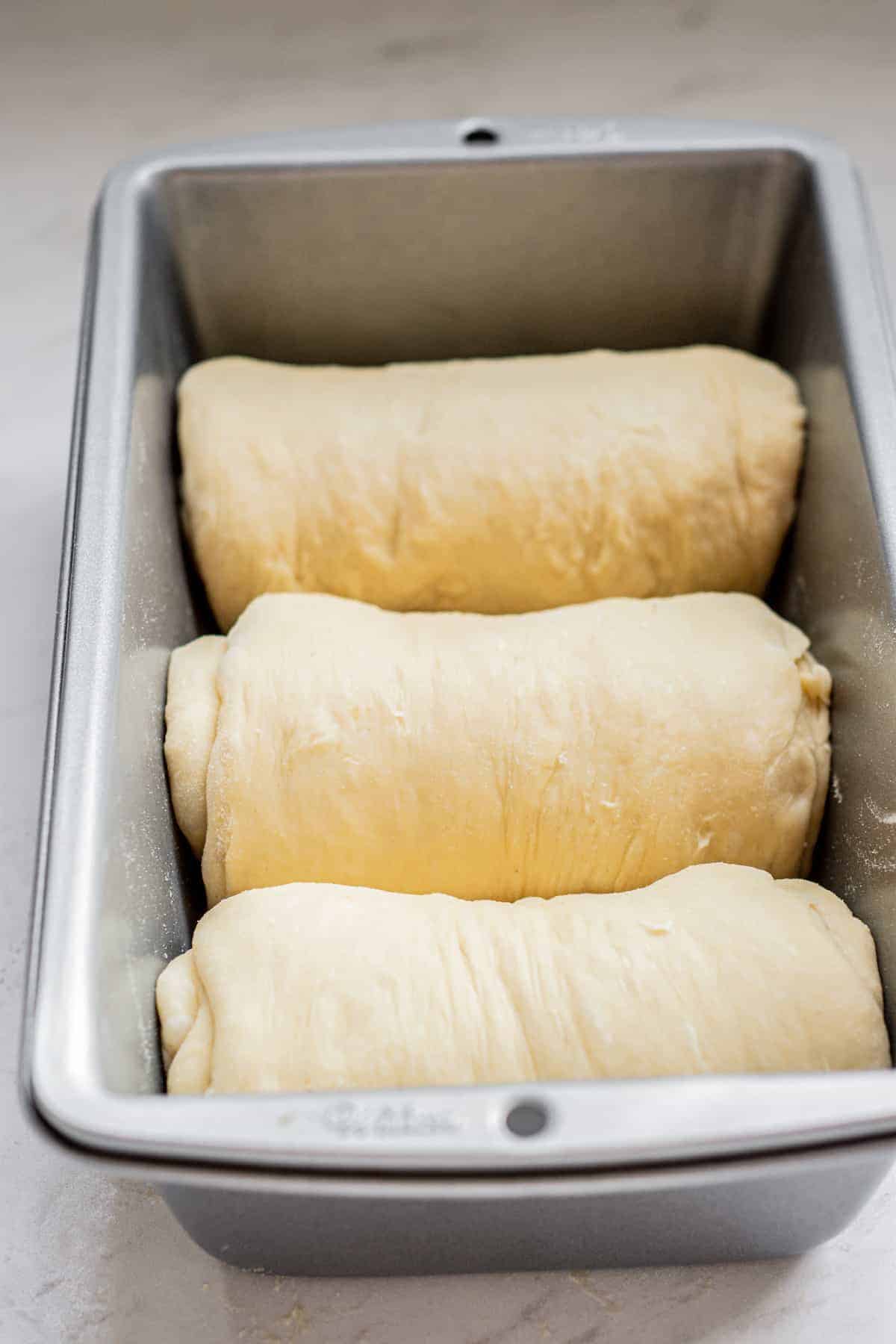
Use a rolling pin to roll each dough ball on the work surface into a long oval shape, around 20cm/8-inches in length.
Roll up each piece like a swiss roll. Place each roll into a greased or parchment paper-lined 9×5 inch loaf pan.
Second rise
Cover the baking pan with compostable plastic wrap or place it in a warm place to rise again until doubled in size.
Baking
Preheat the oven to 350°F/180°C
Mix together an egg with a tablespoon of water and brush the top of the dough with this egg wash.
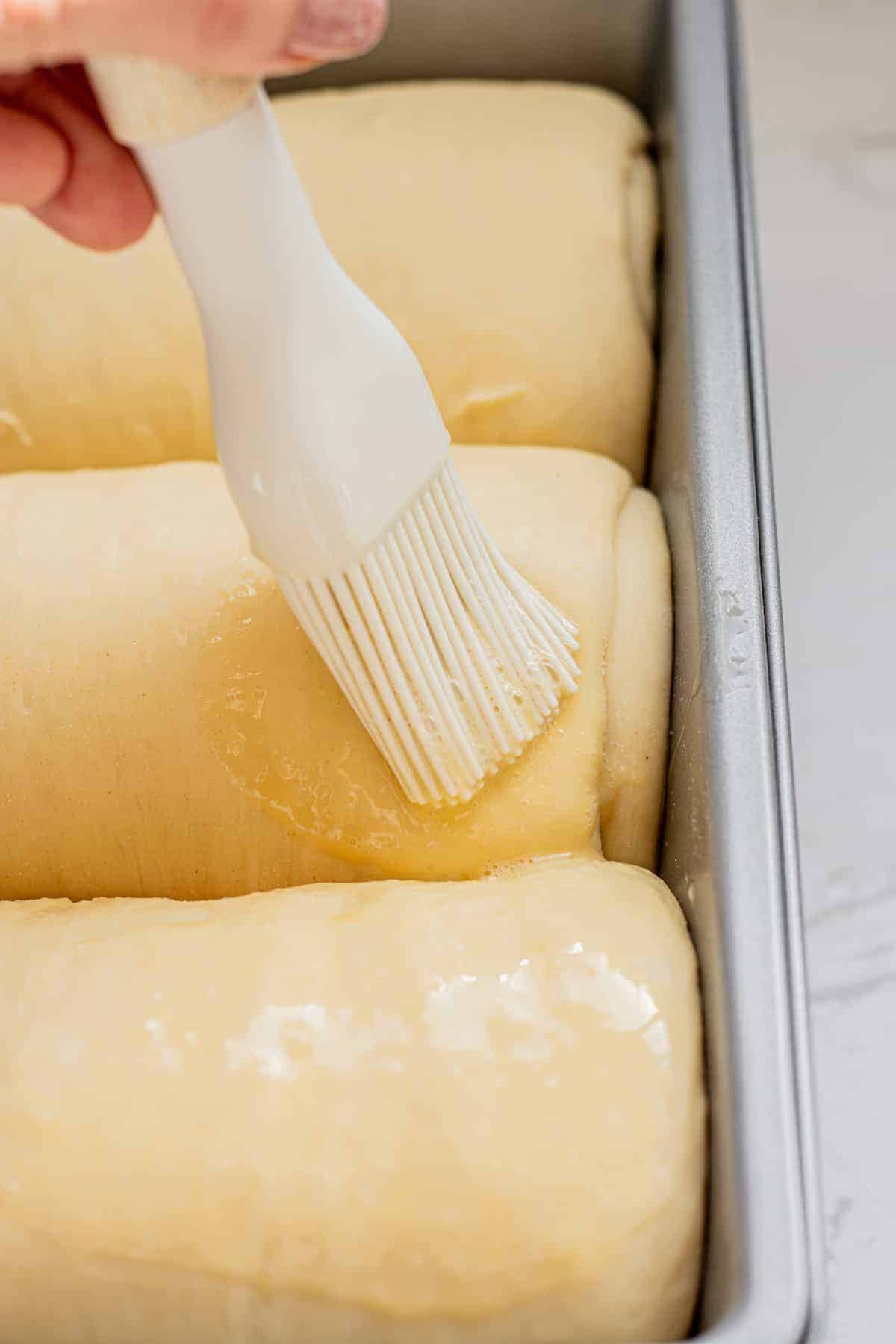
Bake the bread in the preheated oven for around 30-35 minutes until deep golden brown on top. If you find the bread is browning too quickly, loosely cover it with aluminum foil.
When you remove the bread from the pan and tap the bottom of it, it should sound hollow. The internal temperature of the loaf should be around 200°F/94°C.
Remove the bread from the pan and let it cool on a wire rack.
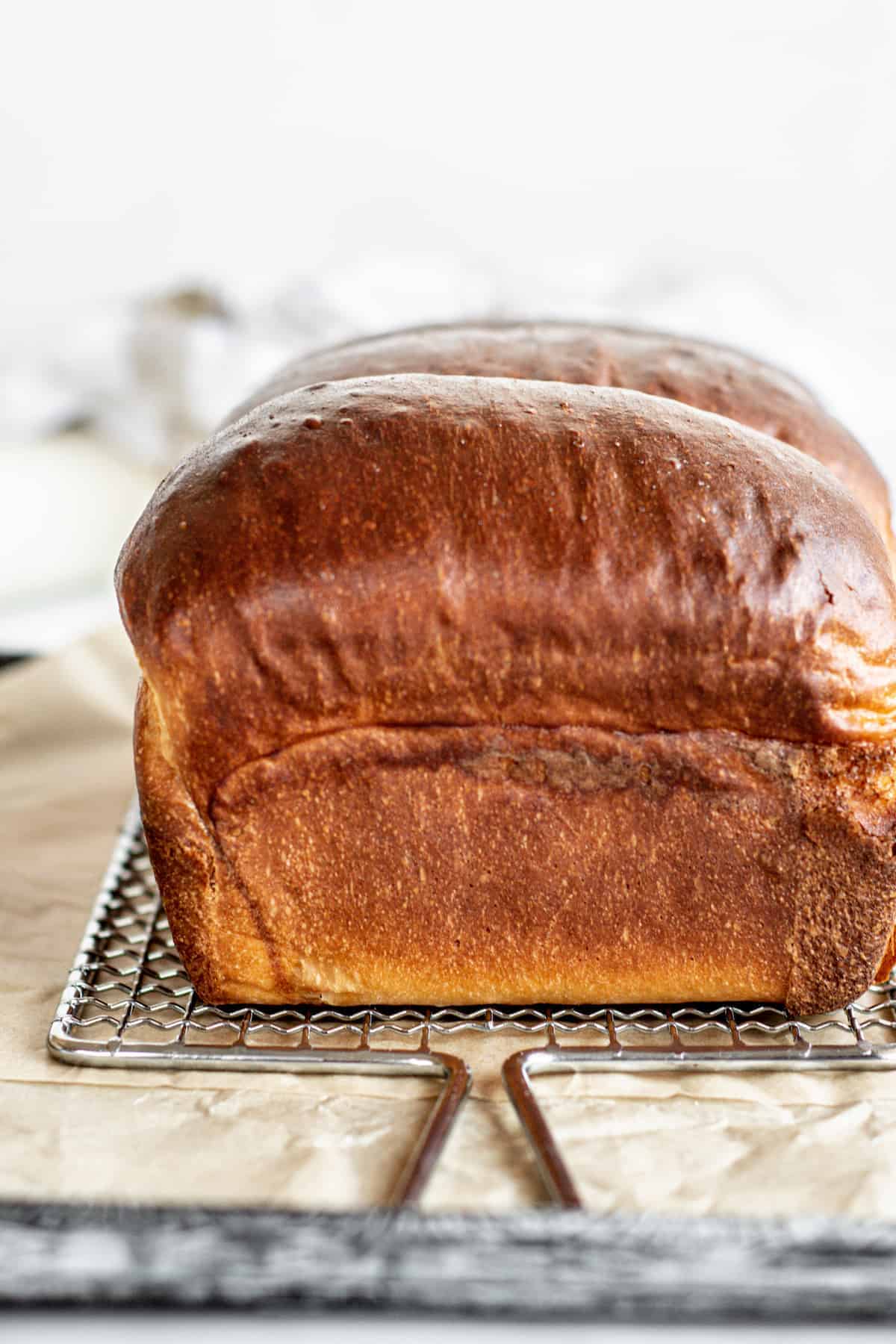
Serving and storing
The bread can be served slightly warm or cooled at room temperature. It’s delicious to tear into when just a little bit warm. If slicing it for sandwiches, let it cool completely.
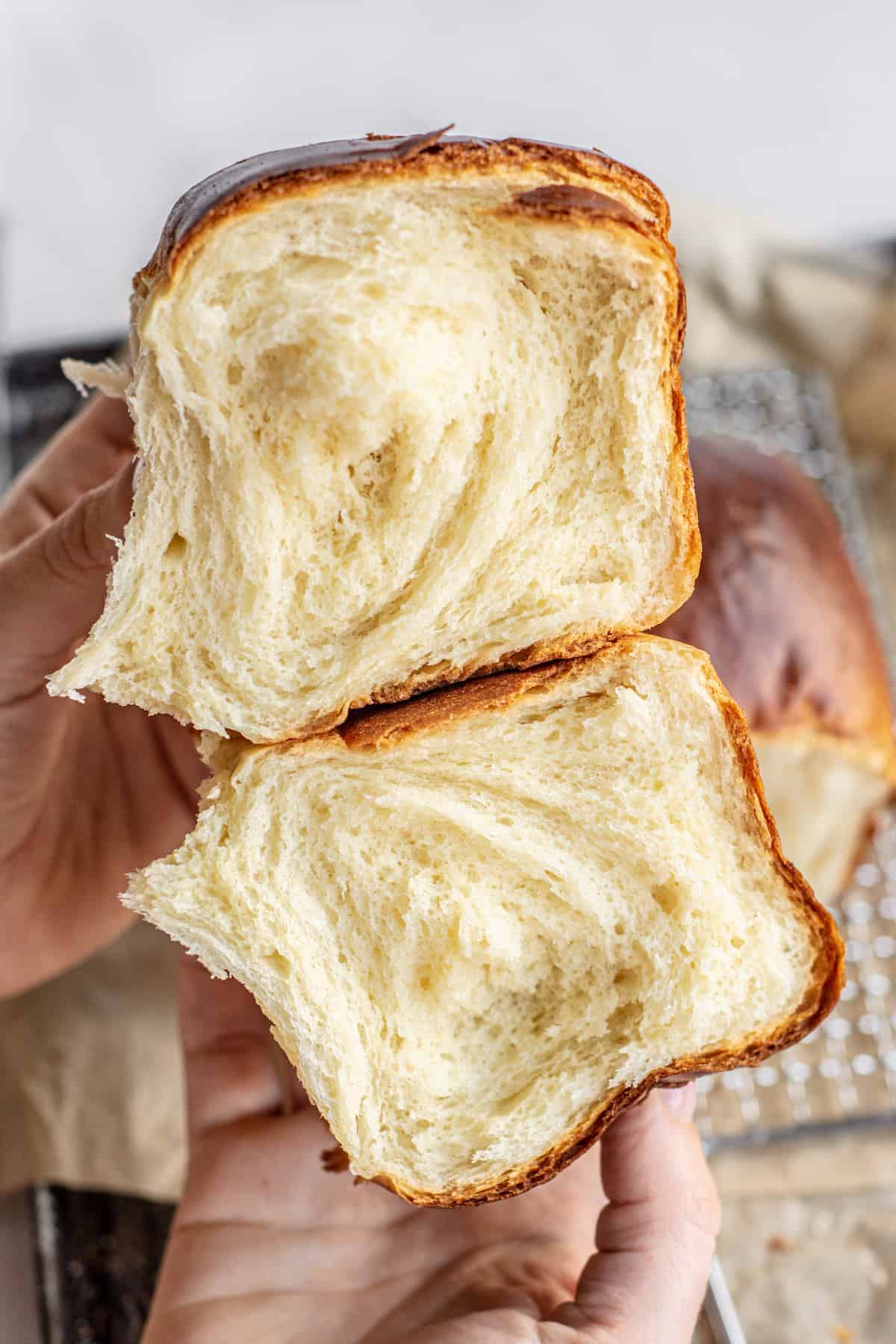
Store leftover bread in an airtight container, or tightly wrapped, at room temperature for up to a week. Leftover milk bread makes amazing french toast!
The bread can also be frozen for long-term storage, up to 3 months.
FAQS
The Tangzhong method involves cooking a portion of the flour and milk to create a soft paste. This process gelatinizes the starches in the flour. It allows them to absorb more liquid and produces a softer, more tender loaf.
It’s best to use bread flour because of its higher protein content, which helps develop the gluten structure necessary. All-purpose flour can be substituted but it results in a less fluffy loaf.
I would not recommend mixing this by hand. If you choose to, expect to spend a lot of time kneading the dough to develop the gluten structure properly. This can take around 15-20 minutes or more of kneading, and it takes a lot of arm muscle!
This bread has a subtle sweetness. It’s nice and versatile for both sweet and savory uses.
You can customize this bread by adding ingredients like chocolate chips, raisins, or even matcha powder for flavor. For filled bread, portion the dough and wrap it around fillings like red bean paste, custard, or savory options like cheese and herbs.
Related recipes
If you enjoyed this Hokkaido milk bread, you might like these bread recipes too!
- The Best Coffee Cinnamon Rolls
- Easy Challah Bun Recipe
- Pumpkin Yeast Bread with Raisins
- Sourdough milk bread
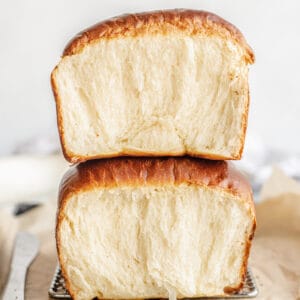
Hokkaido Milk Bread Recipe
Ingredients
Tangzhong
- 24 g bread flour
- 120 g whole milk
Bread dough
- 120 g whole milk
- 25 g granulated sugar
- 1 1/2 teaspoons instant yeast or active dry yeast
- 1 large egg
- 3/4 teaspoon salt
- All the tangzhong
- 312 g bread flour or all-purpose flour
- 55 g unsalted butter, room temperature, cubed
Egg wash (optional)
- 1 egg + 1 Tablespoon water
Instructions
Tangzhong
- Combine the flour and the milk for the tangzhong in a small saucepan. Place this over medium heat and whisk constantly until the mixture is cooked into a thick and glutinous paste.
- Remove it from the heat and scrape it into a small bowl. Let it cool down until just lukewarm to the touch.
Dough
- While the tangzhong is cooling, combine the warm milk, sugar and yeast in the bowl of a stand mixer. If using active dry yeast, let this sit for around 5-10 minutes until it becomes foamy, if using instant yeast this step can be skipped.
- Add in the cooled tangzhong, the dough flour, egg and salt. Turn the mixture onto low speed and combine it into a shaggy dough.
- Turn the mixer to medium speed and mix for 5 minutes until the dough gains some strength.
- Add in the softened butter a few cubes at a time and continue kneading for a further 12-15 minutes until the sticky dough is strong and pulls away from the sides of the bowl.
- Let the dough rest for 5 minutes, then break off a piece and see if it can stretch out really thin without tearing. This is called the windowpane test and is a good way to see that the gluten has developed enough.
First rise
- Add the dough to a lightly greased bowl and cover it with plastic wrap, a damp kitchen towel or a lid.
- Let the dough rise in a warm place until doubled in size, around about 1 – 1 1/2 hours. The exact rise time will depend on your room temperature.
Shaping
- Punch down the dough and pull it from the bowl onto a floured work surface. Weight the dough, then cut it into 3 equal pieces. Use a scale to get really equal proportions. Shape each piece into a ball, using a little flour on your hands and the tops of the dough to stop them from sticking.
- Use a rolling pin to roll each dough ball on the work surface into a long oval shape, around 20cm/8-inches in length. Roll up each piece like a swiss roll. Place each roll into a parchment paper-lined 9×5 inch loaf pan.
- Cover the baking pan with compostable plastic wrap or place it in a warm place to rise again until doubled in size.
Baking
- Preheat the oven to 350°F/180°C
- Mix together an egg with a tablespoon of water and brush the top of the dough with this egg wash.
- Bake the bread in the preheated oven for around 30-35 minutes until deep golden brown on top. If you find the bread is browning too quickly, loosely cover it with aluminium foil.
- When you remove the bread from the pan and tap the bottom of it, it should sound hollow. The internal temperature of the loaf should be around 200°F/94°C.
- Let it cool on a wire rack.
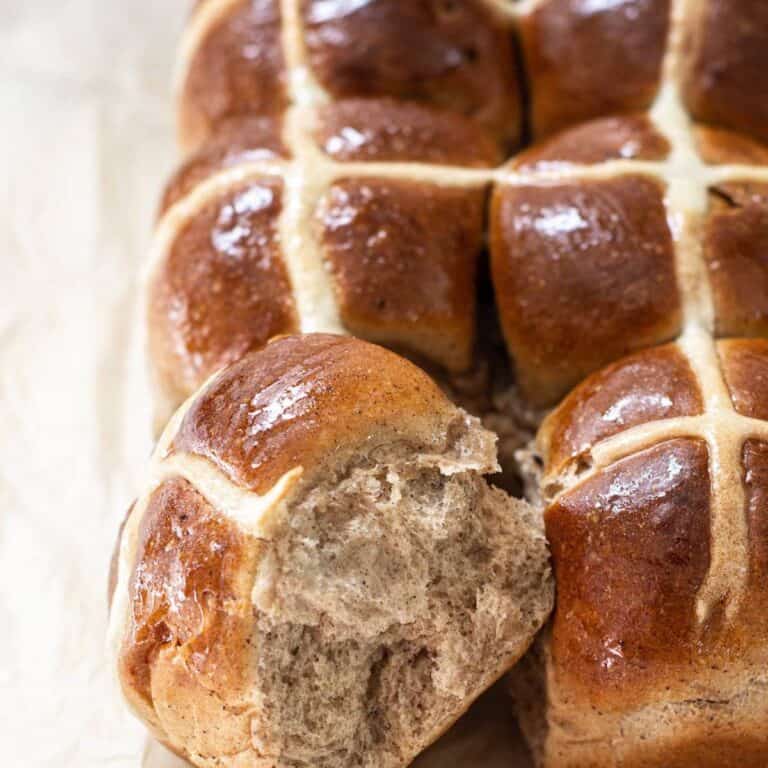
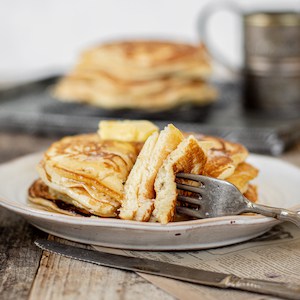
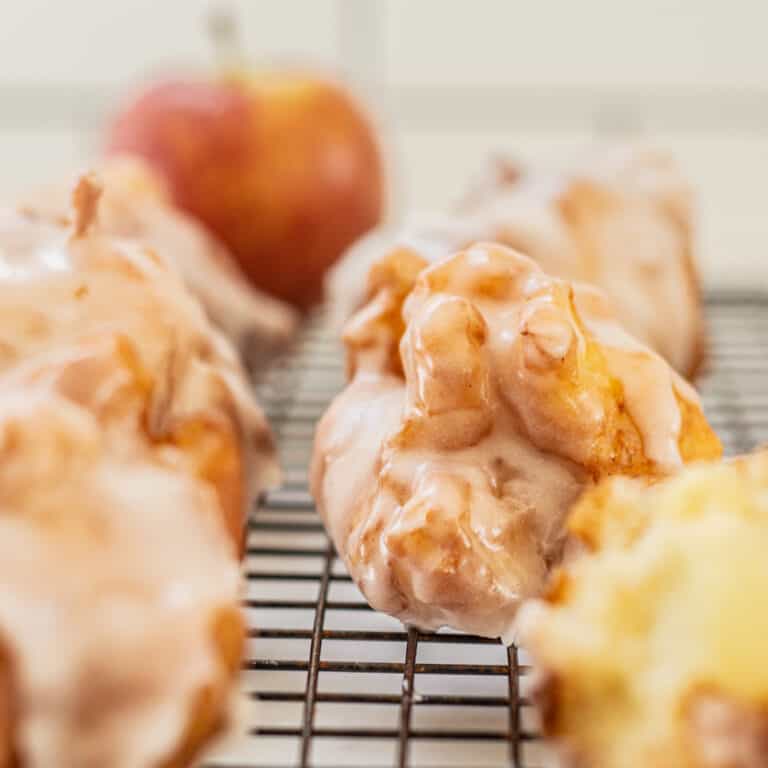
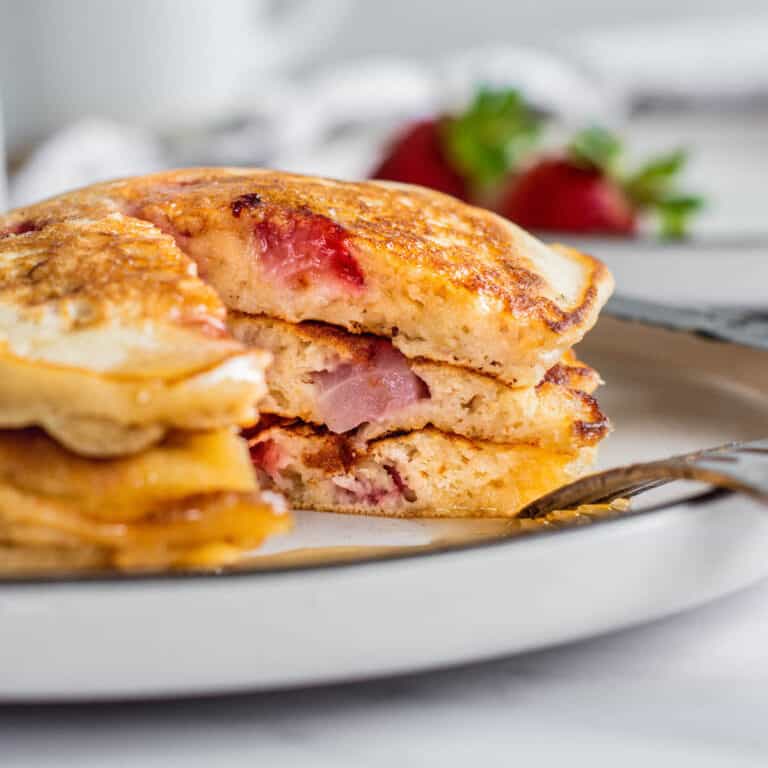
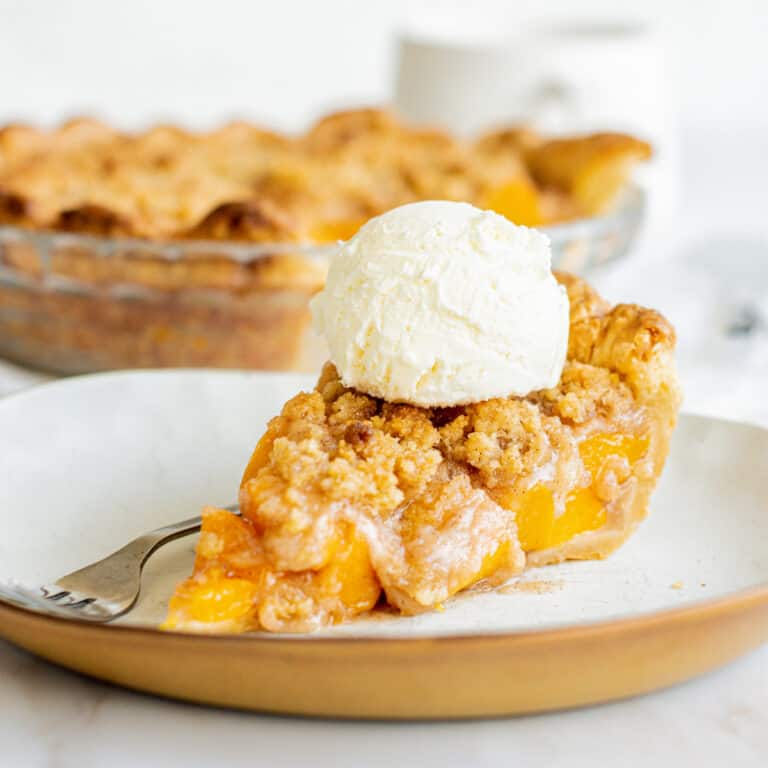
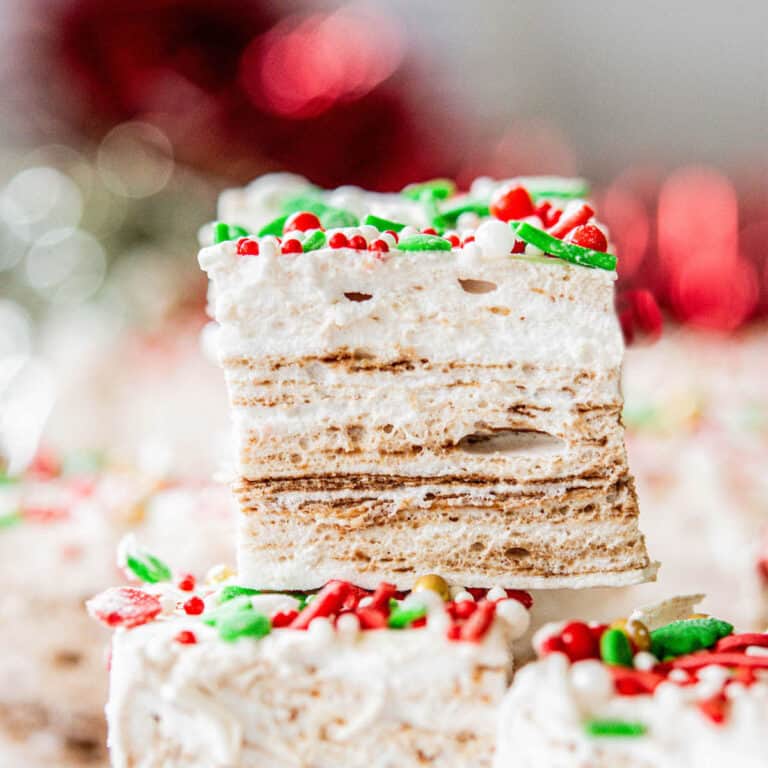
Hi Elien,
I tried this bread, it‘s so fluffy and good. I wonder if I could dopple the ingredients for two breads or is it better to make two single loafs.
Hey Annie, so pleased you enjoyed it! You can double the recipe 🙂
Holy moly, this is the bread I have been searching for, it’s soft, it toasts nicely, and the taste? So delicious, the first time we made it, my hubby and I, ate it in one evening, he said, this is our bread, I don’t need to look any further, so thank you so much for sharing this